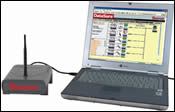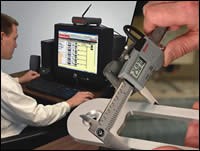Wireless Collection Of Measurement Data
In manufacturing, reacting to measurement data in a timely fashion is critical. A fast response to undesirable trends can prevent scrap or rework. The problem is, it can be slow and cumbersome to collect, deliver and analyze measurement data. Recent efforts to expedite this process have included shop-wide cable networks with bar code readers and other automated devices. The latest development along these lines is wireless data handling.
Share




In manufacturing, reacting to measurement data in a timely fashion is critical. A fast response to undesirable trends can prevent scrap or rework. The problem is, it can be slow and cumbersome to collect, deliver and analyze measurement data. Recent efforts to expedite this process have included shop-wide cable networks with bar code readers and other automated devices.
The latest development along these lines is wireless data handling. Because the value of measurement data is so “perishable,” this application of wireless technology is particularly urgent. However, radio communication in the factory has raised concerns about reliability and security, despite the fact that an effective wireless system has compelling advantages. Wireless devices are highly portable. Wireless networks are more flexible, less expensive to install and more easily reconfigured than hard-wired networks. Most importantly, data can be collected and transmitted almost instantly, without manual entries that are subject to human error.
The DataSure wireless data collection system from Starrett (Athol, Massachusetts) shows the efforts that are being devoted to relieving worries about wireless networks. This system consists of three primary elements: miniature radios (called End Nodes) that are attached to the data output ports of electronic measurement tools, a central receiver/transmitter (called a Gateway) that connects to a laptop personal computer and routers that relay signals back-and-forth on the network while protecting them from interference.
In operation, the system gathers data from the electronic devices as measurements are made and sends them to the host computer by the shortest or strongest connection path. Each measurement is time-stamped and logged into a database. Once data is received, a confirmation signal returns to the sending device, lighting up a green diode. In case the host system is down or busy, readings can be stored in the End Node and resent until they are safely recorded.
Each radio’s range is approximately 100 feet (30 meters). Adding routers can increase the range in 100-foot extensions to as many as 3,000 feet. By placing the routers strategically in overhead locations throughout the shop or factory, the network forms a “mesh” ensuring that signals are relayed reliably.
The system works with micrometers, indicators, calipers and other types of digital metrology instruments, including those from other manufacturers. According to the developers, the software is compatible with most statistical process control (SPC) packages. That relieves another worry users might have—overdependence on proprietary technology.
.png;maxWidth=970;quality=90)



















.png;maxWidth=300;quality=90)






.png;maxWidth=970;quality=90)